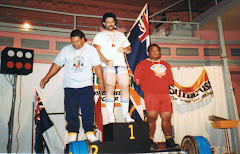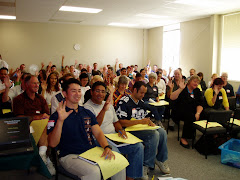
I've been consulting to corporate business teams for a number of years now. The typical situation I'm called into, is where a team has a number of internal conflicts that need to be resolved to get them back to being effective in relating to one another and the service they provide. Having been in many worse case scenarios, and seen the massive costs incurred when a team goes off the rails (or an individual for that matter).
I decided that a strategy is needed to minimise the likely hood of a team descending into the pits of "conflict-hell" to never be seen again. It costs so little to be proactive in minimising team conflict, in comparison to the high cost of both the tangible and intangible costs that arise, as unaddressed conflict escalates. (I have written in an earlier blog, on the cost of conflict).
The 4 Steps
The most effective way to minimise the likely hood of future conflict and maximise the level of engagement and productivity within a team is to follow the simple and trialed process like the 1 I have outlined below:
1) Interview each of the team members (approxiamately 1 hour each) and discover what expectations they have of the other team members and the leadership of the team. If it's conflict - find what specifically is the conflict centred around. You will identify both the commonality of concerns and also the idiosyncrasies. I mostly focus on the common themes the interviews present.
2) Bring the team together for a 1 day facilitated session and integrate the interview findings. Some of the content presented is to define what a healthy and unhealthy team does and describe the negative and positive outcomes of each end of this continuum.
2A) Establish team agreeance on how to better interact with one another. Outline the common expectations of the team as a whole, made up from the individual expectations found in the 1:1 interviews. (i.e. respect, honest and open communication etc...) Some of what is covered is the defining of how they will meet and greet, and also make up when things go wrong. A subjective team score of how healthy they perceive the team to be is taken early on this day
3) Within 7-10 days of the team day session. Provide support byway of 1:1 coaching. The coaching is to iron out any individual difficulties that each of them may have in meeting the team rules of engagement. The session is also an opportunity to de-brief the 1 day team session and provide the written notes from the day to each of the staff. The coaching session may also require additional support models/frameworks and principles, in de-escalating inter-relational conflict.
If it is a serious conflict situation, then an additional 1-3 coaching sessions of 1 - 1.5 hours may be necessary. This is always dependant on the level of escalation or not (the subjective team score is 1 indicator I use to determine the level of escalation). A critical situation may require email & phone contact out of hours, and coaching for 1 hour each week for 2-3 weeks following the initial 1st team day out. In a healthy team environment this would likely only require 1 coaching session within a week of the day out, followed by another coaching session 3-4 weeks later.
4) Finally, a 1/2 day review session to debrief their progress and re-score the teams perceived level of health to evaluate their level of progress. Typically a team will have resolved their conflicts by the time of the debrief, and positively established how they will interact with one another both now and in the future. Should any follow on be required, I recommend a 1/2 day review check-up every 6-7 months. This is where finetuning can be done and ensures the long term health of the team while minimising any future conflict.
This 4 step process will eliminate conflict and establish high performing agreements between the team from which they can operate from on a daily basis. Saving 10's of thousands of dollars in lowered productivity, personal grievances and stress leave!!!!
What I am outlining here (below) is a brief overview of what I do with either teams in conflict or teams wishing to go to the next level of performance.
Background
In a typical situation, where I may be asked to either rectify a conflict situation between team members or alternatively assist a high performing team to establish "rules of engagement" to maximise their results in productivity and engagement. In either of these situations I would present the team with an overview of what behaviours I have seen unhealthy teams demonstrate and also what high performing teams demonstrate. In doing so, creating a sliding continuum of good and bad behaviours between the 2 and also to provide an opportunity for the team to measure what their subjective team health scale is.
I ask the team to score their personal level of how the team is doing. A score of "1" means this is a terrible team to work with and "10" means this is the very best team to be working with! I allow them to score a .5 and they write their score on a post-it-note for anonymity. Once the scores are in, I present them with the team average (i.e. say a score of 5.5). This is often surprising for some and confirming for others in the team.
Interpretation of the Score

The score that the team provides gives "their" perception of reality. The score is both an emotional and critical evalutaion that they have made based on their experience in the here and now. The following table is a brief description of the scaling system I present to the team so thir score can be interpreted.
10: I've never had any team score a perfect 10. If I did I'd likely have a team who over rates themselves! A 10 is a score that I consider unattainable and not the goal of a team to attain but rather to be relentlessly pursuing it.
7-9: Green Range: This is the range of a team who has a strong foundation to take what comes and deal with the stresses and strains of a high performing team. My preference is for the team to score and 8 or a .5 either side is acceptable. A score of 7-9 allows for the ups and downs a team will experience. They will have a clear understanding of how to effect change, and de-escalate conflict when it happens.
4-6: The Amber Range: This is the needs attention range. A score of 4 & 5 indicates they have some internal difficulties. They are likely to have inter-relational problems and will only improve as a result of establishing clear expectations of one another along with guideines on how to manage themselves and how to fight fairly. if there was no intervention the score will slide down as a result of natural attrition due to the fact they need some assistance to right themselves. They definitely have a good chance to be a 7-9 if guided correctly. A score of 6 is on the cusp of a 7-9 and will rise to a 7-9 with ease and some gentle direction from coaching.
1-3: The Red Range: Ok this is the "we got some work to do" end of the scale. It's likely you have numerous inappropriate behaviours by some in this team which are pulling the others down. Staff will be looking at leaving and or filing a personal grievance. This is a critical group in difficult conflict, and will require constant attention until the situation is righted. Staff may have already been off work, on stress leave, and even prescribed medication to manage stress levels. This range requires a specialist approach to resolve the situation. It must first be stabilised and then developed to move towards and beyond the Amber Range, into the Green Zone to reach a score of between 7-9.
This last group can be saved! (Yes, I know you may not think so because you're buried in it!) It will take some time and concentrated effort. Worst case scenario is you may lose staff in the process. From personal experience, I have found the people involved are crying out for help, and also may be blinded by the problems to the degree that they can not comprehend that a positive solution is at all possible. (Which it is by the way!!!)
Closing Comments
The need to have a proactive approach to minimising conflict and establishing performance expectations within teams is a must. I have made the mistake of not putting in place all the steps I have listed (attempted a short money saving approach) and had very poor results due to not following the entire process. To me, this is unacceptable and I know longer accept short-cutting this process. You can always avoid doing any of what I have suggested above, and you will, at a later date, pay the ultimate price = team failure.
Prevention Rather Than a Cure
We are encouraged to have regular medical check ups - yet how many of us actually do that? And at what cost for not doing it? We usually only go to our local GP when things are bad. This is what I have found also with work teams. I have businesses approach me to resolve team conflicts, when all it would have taken, was the simple 4 step process I have briefly outlined above. That small investment in time and money would have prevented the need to begin what can be, a very difficult & expensive road to team recovery.If you want a productive year and want to minimise internal conflict then this is a must. Alternatively you could say - "We're doing just fine..." and ignore the need for that check up until it is often way too late. Be proactive and enjoy the long term benefits, especially in our current recessive times of needing to do more with less.
N.B. What I have outlined here is a highly skilled area of facilitation and coaching. It is not for the faint hearted nor a place for the inexperienced. I offer training in how to do this process if your're interested or alternatively if you'd like the process facilitated for you.
For more details - email me for a more in depth understanding on how teams can minimise conflict and increase their level of engagement in the workplace.

















































No comments:
Post a Comment